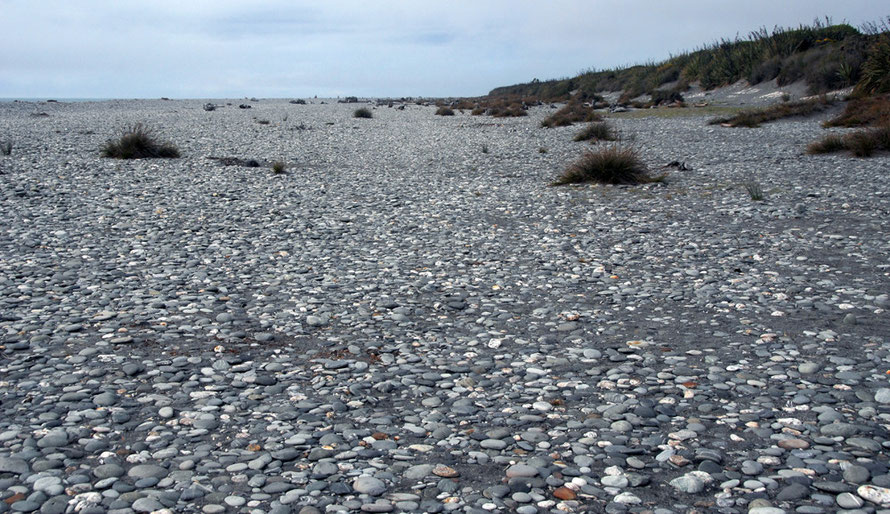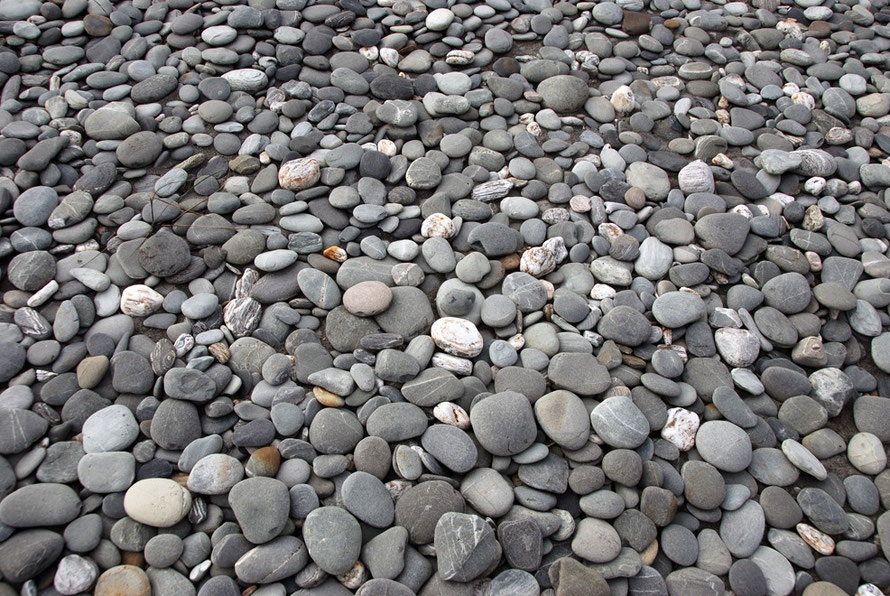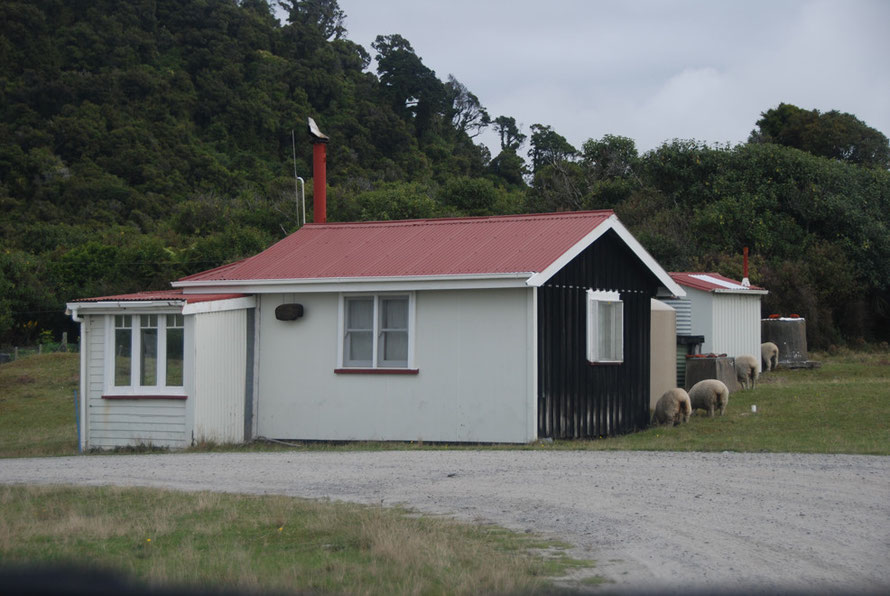VII. Gillespie's Beach
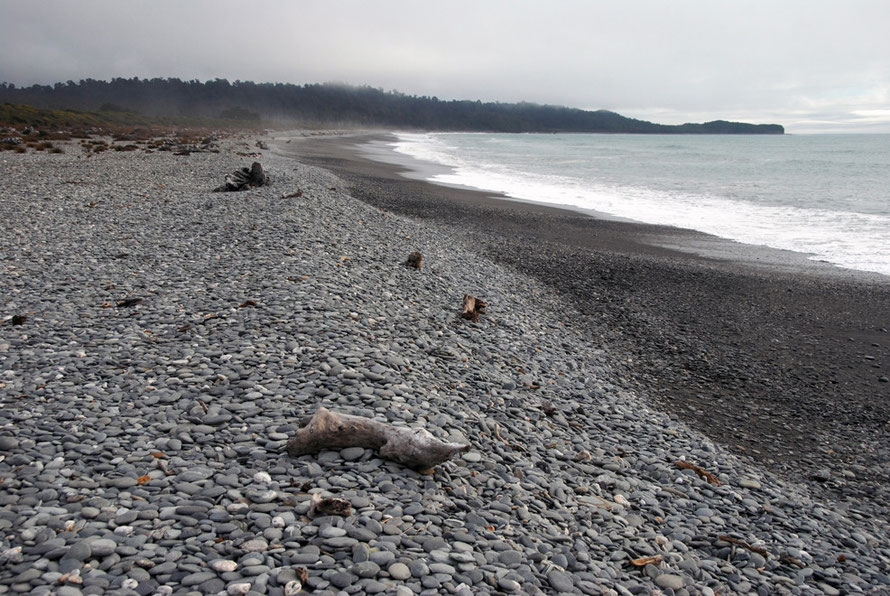
After a long day up the Fox, so to speak, we drove the road to the Mt Cook Viewpoint - a couple of tracks in the grass by Rocky Creek - on the flats below Fox Village. But the cloud ceiling had come right down on the mountains. We passed emerald green pastures and solitary remnant trees slightly ridiculous in their Ken Dodd-like frowsiness.
We took a side road to Lake Matheson, a kettle lake formed by the Fox Glacier in one of the ice ages, hoping we might see the lake and its famed reflections of the mountains from the car. Instead we got to a great big cafe and car park that was all shut down.
Rather than get out and face the sandflies we felt sure would be out in force in the muggy, still air we backtracked and took the serpentine gravel road to Gillespie's Beach. It went on for ages, blind curve after blind curve, through thick forest.
We were ignorant of the importance of this forest that had been the site of conservation struggles in the second half of the 1970s. It forms part of the Waikukupa Forest and was added to the Westland Tai Poutini National Park in 1982 thus preserving the natural landscape and fauna in the park from the Tasman Sea shore to the highest peaks of the Southern Alps with the exception of the alluvial plains:
The only local landscape not well represented is the alluvial flood plains with their forest and wetland communities (Westland Tai Poutini National Park Management Plan 2001-11 p. 49).
We finally broke out onto a gravelly flat covered in over-headheight gorse and brambles with a scruffy lot of sheep weaving in and out of the stuff.
There was a sign stuck in the verge that seemed both funny and sad. It said, 'Tame Canada Geese: Do Not Shoot'. There was a stagnant creek at the side of the road but we saw no geese. I thought, "You could change that round to 'Game Canada Geese: Shoot.'" But I kept schtum.
The only local landscape not well represented is the alluvial flood plains with their forest and wetland communities (Westland Tai Poutini National Park Management Plan 2001-11 p. 49).
The beach car park seemed to have been taken over by a bunch of young, stylishly dishevelled French campervan-ers (despite the signs prohibiting campervans and camping). They were trying to cook under the lean-tos while fighting off the dreadful sand flies. 'Of all the place to plant your flag', I thought, 'why here?'
We stumbled out onto the beach, kept moving quickly, me firing off photos from the hip and ran back to the car hoping to leave the sand flies behind.
There wasn't much to compete with a glacier here. A broad flat beach of broad, flat schist and greywacke pebbles; the Tasman Sea breaking onto the shore. It would have been a great place for a stone-skipping competition
It was a symphony of greys and the landscape was doing that thing it does periodically in New Zealand - going from spectacular and scintillating to flat and existentially threatening in what seemed like the blink of an eye.
The sunlight bled from the sky, the angular illuminating light disappeared and all was rendered both morose and frightening. Or was it me?
Sometimes New Zealand can feel the most lonely place in the world and the huge distance from home and the familiar rushes into the void. No wonder the All Blacks are so good at rugby. You'd want something to dedicate yourself to to keep that lonesome feeling at bay.
Lady Barker wrote about this aspect of 'lonely New Zealand' back in the 1866 on the Malvern Hills sheep run she and her husband were soon to sell to return to the UK after the disastrous winter snowstorms of 1867 killed half their sheep flock and 90% of their lambs (p.72),
But after the house is quiet and silent for the night, and the servants have gone to bed, a horrible lonely eerie feeling comes over me; the solitude is so dreary, and the silence so intense, only broken occasionally by the wild, melancholy cry of the weka. (Station Life in New Zealand, 1870 p.34.)
You can experience the melancholy cry of the Buff Weka here.
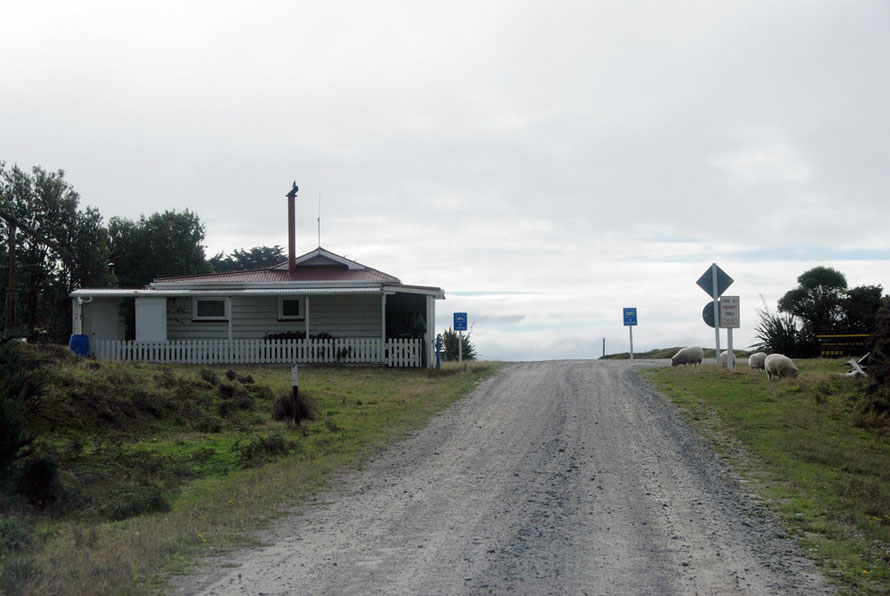
By the side of the car park stood an elongated Department of Conservation sign with dense text and a technical drawing reproduced from Victorian times. It told us about the Von Schmidt Suction Dredge that had once operated in these parts when gold was being got (Wouldn't you know that it was a Gillespie who discovered gold as Gillespie's Beach). A few rusty iron pipe sections lay in the grass but even I had by now had enough.
It told me (I later learnt reading the photo of the sign) that Von Schmidt's suction dredge had been a 'universal failure' and that this was thought to be the last one extant - at least in the few rusty pieces that remain - in New Zealand (which given that it had been a universal failure didn't strike me as all that odd).
It's not the kind of thing you'd go miles out of your way to see but there is plenty more information on the sign should you ever get there.
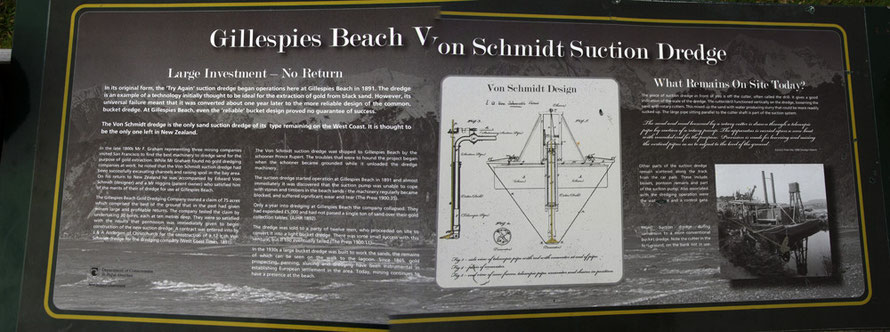
Von Schmidt himself travelled to New Zealand and the Gillespie Beach Gold Dredging Company (it says what it does on the tin) commissioned the dredger to be built in Chistchurch. The complete wonder was then shipped by the schooner Prince Rupert to the beach at a cost of £5,000 - which was an immense amount of money back in 1891 (about £300,000 at 2005 prices).
At this point 'universal failure' set in because the 12 inch suction pipe quickly became clogged by stones and beach timbers (now how did they miss that?). The gold that they hoped to extract from the black sands of the nearby lagoon lay obstinately out of reach.
After a year the grandly named company went bust without having ever successfully dredged anything, not even one ton of gravel and sand let alone any 'dust'.
A group of blokes bought up Von Schmidt's disaster and converted it to a 'light bucket dredger' but even this 'eventually failed'.
A sign directed us to a Miner's Cemetery two minutes away up the creekside but enough was enough. Although now I wonder what was there. As I often do.
It turns out the cemetery was recently restored and held 'haunting secrets' including 'the story of a 17 year old that [who] drowned' in the Cook River in 1890 and a beloved wife from an Irish miner’s camp'.
Again, not the sort of thing to make a big detour for. Although that drowning motif is repeated across the South Island and was the great peril in 19th century New Zealand.
I think it is Lady Barker - as she was known - who repeats the maxim that New Zealander's either die of drink or drowning - adding that the former is usually found not far from the latter (see p.35 Station Life in New Zealand, 1870).
We drove back over the winding road hoping not to run into a 'young tearaway' in a camper van but nothing happened. The cloud seemed even lower as we drove back up the dead strait road to Fox Village.
We passed some red-oxide tin farm buidlngs, a big Hereford bull and a white clapboard church that seemed stuck way out on the edge of the habitation. It was dedicated to 'Our Lady of the Snows'.

We had been really lucky with the weather on our glacier walks. As the early evening light faded the rain started and fell gently through the night. We ate some delicious hot-smoked salmon from a smokehouse further down the West Coast - South Westland Salmon Farm - and fell asleep in our pine-clad room at the Fox Glacier Lodge stunned by all that we had seen.


